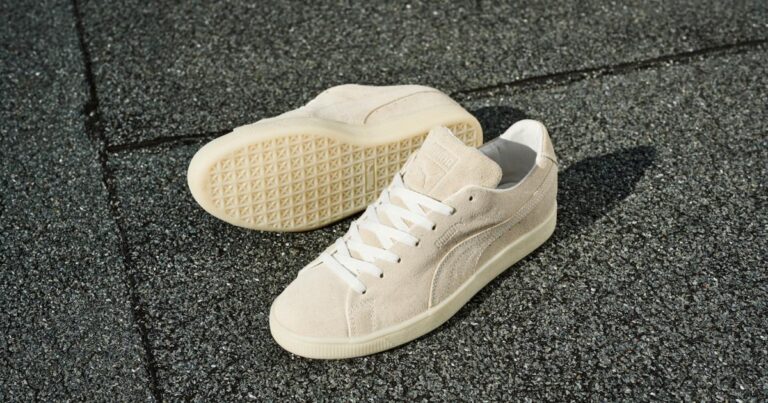On the surface, Puma’s classic suede sneaker has looked the same since 1968, but the company recently unveiled a version that will biodegrade into farm-ready compost. The RE:SUEDE project is the first from Puma’s Circular Lab. The company published the results of its experiment in November after two years of research.
Footwear production accounts for 1.4 percent of annual global greenhouse gas emissions, according to a 2018 Quantis study — roughly equivalent to the emissions of Canada. Manufacturing accounts for 43 percent of those emissions, and extracting and processing raw materials 34 percent, the report found. Making a pair of sneakers generates 30 pounds of CO2, according to an analysis by MIT in 2013. A typical shoe contains several materials tightly sewn together — leather, plastic, cotton, rubber, synthetics and so on — and is thus very difficult to recycle. Ninety percent of old shoes end up in landfill sites.
Puma’s circularity goals for 2025 include offering product takebacks in large markets; halving landfill waste from production; and developing recycled materials for leather, rubber, cotton and polyurethane.
“We must actively move the needle in terms of reducing energy consumption, waste, emissions,” Puma’s senior head of innovation, Romain Girard, said via email. “Circularity is connecting the dots on many of those aspects. … Experimenting with products that eliminate waste at the end-of-use stage allows us to rethink the way we tackle the waste generated from our industry,” Girard said.

The Bavarian shoemaker released the RE:SUEDE results with a handbook to help other organizations pursuing circular-economy projects.
“By throwing ourselves out there, we have had many inventors, creators and manufacturers reach out to share their ideas with us,” Girard said. “This is important to us as we strongly believe that conversation and collaboration will make the difference.”
How Puma’s experiment worked
In early 2022 Puma invited consumers to join the RE:SUEDE pilot, selecting 500 people from 2,000 applicants in Germany to wear the shoes about twice a week for six months.
Puma sought to answer four questions:
- Could Puma make a compostable shoe that people actually liked to wear? More than two-thirds of pilot testers said they would recommend the RE:SUEDE to others, although 57 percent said it was uncomfortable.
- Would participants mail back the shoes for composting? Four hundred and twelve of them did.
- Could the shoes transform into farm-ready compost? Not entirely. The uppers decayed well enough to be used as standard compost but the soles took too long.
- Could it scale? Puma’s Circular Lab is exploring new projects, including its RE:FIBRE textile recycling effort with professional soccer jerseys.
How the shoes composted
The key issue, of course, is whether the shoe will actually degrade thoroughly enough to be used in agriculture. Initially, several waste management companies declined to work with Puma, because introducing new materials to an industrial compost facility risks contaminating the compost.
Yet the project piqued the curiosity of Marthien van Eersel, Ortessa’s manager of materials and innovations. “We thought about it and said, what the heck, let’s see what it is,” he said. “We have a special testing method, where we can introduce biodegradable materials into our terminal, [and] they will not contaminate the rest of the green household waste or the compost that we make.”

The private Dutch company’s Valor Composting Facility turns 50,000 tonnes of household food waste and garden trimmings into 24,000 tonnes of Grade A compost for farms each year.
Between March and June, Ortessa mixed Puma’s shoes with the green waste from homes and left them to break down at high heat inside one of its fourteen 150 square-meter concrete tunnels.
Every two weeks, the company sieved the decaying material — anything smaller than 1.5 inches in diameter is compostable; under .4 inch becomes Grade A compost.
RE:SUEDE’s uppers are made of hemp, cotton and Zeology suede, tanned with a nontoxic zeolite-based formula. Those materials degraded fairly quickly. After 2.5 months, most of it was usable. But Ortessa expected the soles — made from TPE-E, a flexible polymer — would have needed about four more months to fully break down.
Expanding the inputs for compost
Ortessa is helping a handful of other corporations to test whether textiles, disposable food packaging, cups and eating utensils can be composted. With enough volume from businesses paying Ortessa, van Eersel hopes Ortessa could eventually handle more than household waste.

“So for us, the business model isn’t just clothes, shoes, it’s more all the biodegradable materials that have proven in our testing method that they will decompose within our operating parameters,” he said.
Next year, Europe will impose a ban on solid plastic food packaging and paper cups with plastic liners. The use of compostable, fossil-fuel-free cups, boxes and cutlery will rise, and so will the need to manage them, van Eersel said.
Everything old is new again
RE:SUEDE isn’t Puma’s first stab at a biodegradable sneaker. Ten years ago the company launched an InCycle design featuring organic cotton and linen, with soles of APINATbio plastic.

Since then, the technology has improved, Girard said. “The RE:SUEDE is a simple shoe, (comprising) only a few pieces and components,” Girard said. “We are currently working on exploring a similar concept but based on more complex products that have higher functional benefits.”
Blueview Footwear, OAT Shoes and Native Shoes are among the smaller companies also touting biodegradable models. Blueview used algae in its 52-percent biobased foam soles, which it says can biodegrade in the ocean.
Puma has talked to many of these startups, Girard said. “We share the same goals yet here at Puma we are looking at developing innovations that can be applied at scale,” he said. “We see the opportunity to scale up giving more people access to these types of products. We also see the chance to expand the product portfolio in this field with different silhouettes and product types.”


